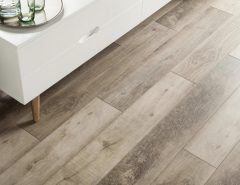Whether you want to freshen up the tile backsplash behind your kitchen sink or revamp the tile in your bathroom, it’s important to know what grout is all about. Although it may seem daunting, grouting tile is actually a pretty easy process as long as you know the right steps to take. In order to help you grout like a pro, here’s a brief DIY guide to grouting your own tile.
Supplies
Before you summon the grout gods, you must first have the proper supplies on hand. For materials, you’ll need grout sealer and the grout itself, which usually comes in one, three, and five-pound bags of powder mix.
As for tools, you’ll need:
- a trowel
- an awl
- a rubber or plastic grout float
- a small paintbrush
- two five-gallon buckets
- a sponge
- a vacuum
- rubber gloves.
Also, have some cleaning supplies on hand to remove any excess soap scum or mildew that’s present on the tile’s surface before you begin grouting.
Prep the tile
As mentioned above, cleaning your tile before grouting is important, but cleaning the current grout itself is also necessary. Using the awl, lightly scrape along grout lines to break up and remove any loose grout and soap scum.
Just make sure you don’t apply too much pressure or you could chip the tile. Once you are finished, go back along the grout lines with a vacuum and make sure you remove any of the loose grout that remains.
Mix the grout
With one of the five-gallon buckets and the trowel, mix the grout powder with water by following the mixing instructions on the grout package. Whether you’re grouting ceramic or porcelain tiles, the grout should resemble the consistency of creamy peanut butter. Anything less or more and the grout won’t adhere to the surface.
In addition, once you reach peanut butter consistency, it’s wise to let the grout set, or slake, for at least ten minutes. This allows the grout mixture to chemically bond, which results in crack-free drying.
Apply the grout (A.K.A. load the joints)
You’ll want to use the trowel to scoop the grout from the five-gallon bucket and load it on the grout float. With the loaded grout float, swipe the grout mixture across the tiles. It’s perfectly fine if the grout gets on the tile, but just make sure you add enough pressure so that the grout loads into the joints.
Clean off the excess
After about 30 minutes, the grout will start hardening, which is when you’ll want to sponge away the excess. Some tile styles call for smooth grout lines and others don’t, so be aware of how much grout you are removing. Fill the other five-gallon bucket with fresh water and use it to continuously dip and rinse the sponge while you wipe.
You don’t want a sopping wet sponge, but rather a slightly moist sponge. If the sponge is too wet, you might accidentally wash the grout lines out. After 48 to 72 hours of drying time, you can apply grout sealer with the paintbrush directly to the grout lines to prevent the absorption of water.
When you are ready to give your tile surfaces a makeover, don’t forget the DIY tips above.



















